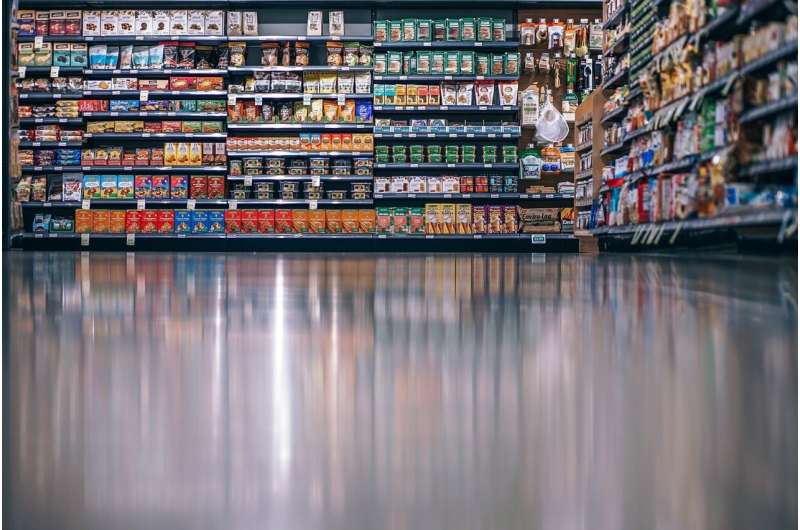This article has been reviewed according to Science X's editorial process and policies. Editors have highlighted the following attributes while ensuring the content's credibility:
fact-checked
trusted source
proofread
Cellulose fibers are emerging as a sustainable option for wrapping everything from foods to electronics

Attention supermarket shoppers in Belgium, France and Luxembourg: a test to cut waste from plastic packaging of foods is coming to nearby stores.
Retailers Carrefour and U-Group plan to sell yogurts, cheeses, fruit juices, biscuits and other items in packaging made of cellulose fibers, which come from wood or other plant-based materials.
Market moves
In total, 30 to 60 stores in the three countries will start featuring the environmentally friendly wrappings on 13 types of food by the end of this year.
Carrefour and U have teamed up with food producers, packagers and researchers in a project to help get green packaging materials into stores.
"Without market uptake, bringing sustainable products to shelves is no more than wishful thinking," said Frank Gana, chief executive officer and co-founder of a Paris-based environmental consultancy named (RE)SET.
It leads the EU project, which is called R3PACK and runs for three years through May 2025.
The goal is for the industry players in the initiative to replace a significant portion of their plastic packaging with fiber-based versions. Food producers such as Candia and packagers including Thiolat—both also based in France like Carrefour and U—are committed to the goal and leading the effort.
The test that will start later this year in Belgium, France and Luxembourg is due to be extended to thousands of stores in the three countries by the time the project wraps up.
Packaging piles
Europe's pile of packaging waste comes from far more than food items. From takeaway coffee cups to boxed-up electronics, Europe generates nearly 190 kilograms of packaging per person each year—or 84 million metric tons in total in 2021.
Plastic packaging is a particular threat because, although some is recycled, much ends up in the ground, rivers and seas. In 2021, almost a fifth of the EU's packaging waste was plastic.
In addition to replacing plastic packaging, the R3PACK team is seeking to make some wrapping reusable.
"For some products it will be nearly impossible to replace plastic," said Gana. "In some cases, it's easier to make reusable packaging.
While consumers, authorities and businesses alike want to reduce single-use plastic packaging, finding a suitable replacement is a big challenge precisely because of the material's qualities: it is light, cheap to produce and can protect the contents inside from oxygen, moisture and water.
One solution is to cover cellulose- or paper-based packaging with lamination or coating—or a combination of both—to bridge the gap with plastic's useful qualities.
Swedish breakthrough
Anna Altner can attest to the challenges—and breakthroughs—in the field of sustainable packaging.
She is the founder of a Swedish startup called Yangi, which developed cellulose-based packaging that can compete with plastic economically.
That's because the company's manufacturing process is less energy- and water-intensive than those of other makers of cellulose-based packaging and because the final product, like plastic, is versatile.
The process is called "dry forming" and relies on air instead of water to separate the fibers, which come from sustainably managed forests in Scandinavia.
"We are much more price competitive, compared to plastics, than existing solutions," said Altner. "Plastic is so cheap, there is no paper solution that can compete with it."
The company's processing breakthrough came in another research project that she led. The project ran from April 2021 until the end of 2023.
Under the new processing method, pulp is fed through a mill to separate the fibers. Air is then introduced to separate them further into single fibers.
With a continuous air-circulating system, the fibers are then formed into fluffy pads that are laid on a formation line. Heat and pressure are applied, creating a rigid 3D packaging made of cellulose.
The method not only saves water but also consumes less energy than current manufacturing methods for cellulose packaging—no small consideration for manufacturers amid high energy prices.
The new packaging could be used for everything from takeaway salad bowls to blister packs for electronics. What's more, it can be recycled in existing paper-recycling arrangements.
Greener frontiers
In December 2023, EU governments agreed to amend European legislation on packaging waste to increase the reuse of packaging and make all of it recyclable.
That ties in with the European Green Deal and EU drive towards a more circular economic model in which resources find their way back into the economy for reuse instead of being discarded.
"We're seeing the same trend towards tightening regulations on packaging globally, even if Europe is ahead," Altner said.
For his part, Gana of (RE)SET said that tackling plastic packaging could help pave the way for deeper across-the-board cooperation in Europe to green the economy.
"If you want to run a marathon, you need to start with a 10K," he said. "Packaging is a good first step."
Provided by Horizon: The EU Research & Innovation Magazine





















